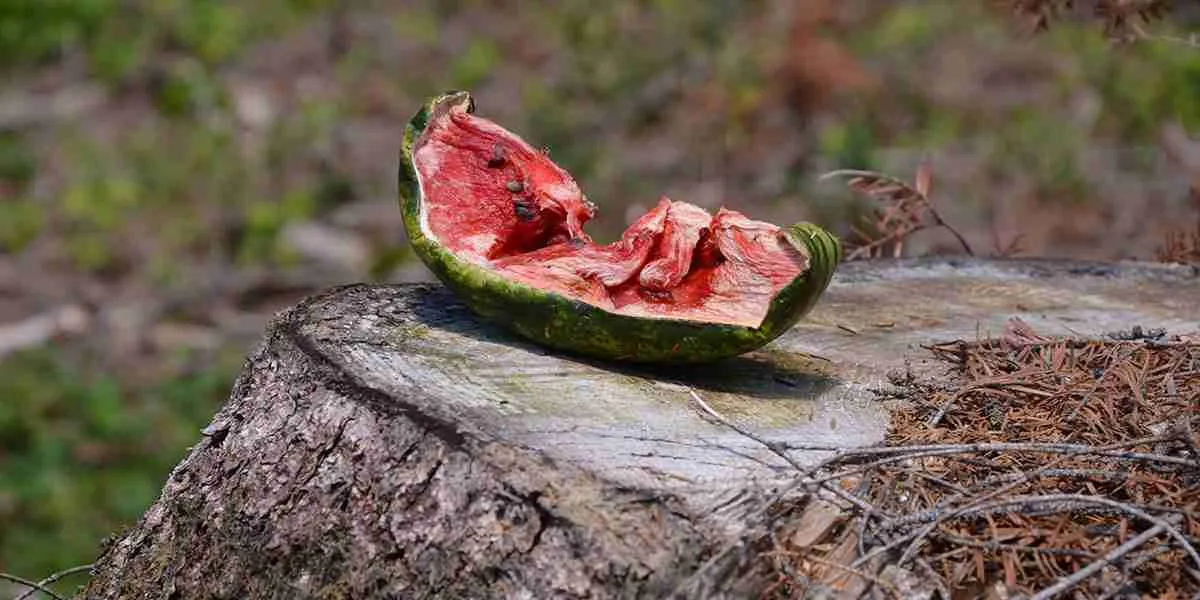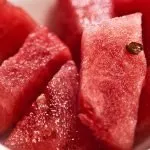Are you unsure if your watermelon is ready to eat, or overripe? The signs of a watermelon gone bad can be subtle at first, and become increasingly obvious as the fruit starts to rot. We will outline the most common fruit rot symptoms in this overview.
Proper storage can prolong the amount of time you can safely consume fresh produce. Storing a fresh, ripe watermelon is only possible for a limited amount of time:
- Uncut fruit at room temperature: 1 week
- Uncut fruit in the fridge: 2 weeks
- Cut slices: 3-5 days
A spoiled watermelon can quickly lead to food poisoning. According to the US Center For Disease Control And Prevention (CDC), signs of food poisoning might include an upset stomach, fatigue, headache, nausea, vomiting, and diarrhea. Let’s prevent that by understanding the most important signs of an overripe watermelon.
1. Watermelon Skin Turns Soft
Do you know how you usually have to press the outside of the fruit in order to assess its ripeness? Watermelon might be a little bit bigger, but the same concept still applies here. Press that big green ball to see if it’s ready to eat, or if it’s past the expiry date already.
If the outer skin has turned soft and squishy, that might indicate the fruit is past its expiry date.
It’s very easy to confuse ripeness with overripe squishiness. Both allow the skin to be pressed inwards, it’s just that overripe fruits squish inwards a lot more. If you think your watermelon might be past its expiration date, don’t use this information in isolation. Instead, look for more signs of fruit rot.
2. Edible Flesh Turns Pale Pink Inside
Discoloration of the edible flesh is the next obvious sign of an overripe watermelon. Whereas the watermelon flesh inside should look vibrantly red, over time it might slowly turn pale and pink. If the fruit is old it will have a light pink color, not a warm and bright kind of pink.
The red color of a watermelon is caused by lycopene, an antioxidant that is also found in tomatoes. The substance pigments the fruit and turns it red, but over time the ripeness will decrease the amount of lycopene in the fruit.
Watermelon that looks pale-pink has lost much of the vitamins and minerals that are inside. It will also start losing a lot of moisture. Biting into the pink flesh of an old watermelon will be a lot less juicy, with an almost gritty texture.
3. Dryness And Cracks In The Flesh
If you happen to cut an overripe watermelon in half, the first thing you’ll notice is the pale-pink color of the flesh. Immediately after that, you’ll notice how dry the flesh actually is. That’s not supposed to be like that, because otherwise, we would have called it a ‘drymelon’.
As a direct consequence of the dry flesh, cracks might start to emerge across the fruit. The thing simply rips itself apart, because of the lack of moisture. This is an obvious sign of an overripe watermelon!
Compare it to dry soil on a warm summer’s day. If no rain falls for weeks on end, the soil will be so dry that cracks start to emerge in the ground. The same concept applies here. But the watermelon won’t be completely dry. It will still contain some moisture. The texture of an old fruit definitely won’t be the same.
4. Gritty And Mushy Texture
Have you ever had a slush puppy? You know, fill a cup with sugary juice and ice cubes, then proceed to crush the cubes into slush. Much like a watermelon, very refreshing in the summer. That slush puppy texture is what an overripe watermelon would feel like in your mouth.
We’re sorry for slightly ruining slush puppies for you. But trust us, they’re not super healthy. And neither are overripe fruits.
If you ever experience a gritty, mushy texture in combination with pale white watermelon flesh, it’s better to avoid the fruit. Ingesting some of it won’t hurt a healthy person, but too much might cause symptoms of food poisoning, or worse. If the odd texture won’t deter you, it’s probably the flavor that will, though.
5. Strange Sour Taste
The flavor of the watermelon is another thing that might be affected over time. Whereas an underripe fruit will taste very bland (not sour at all, but not sugary either), ripe watermelon will taste obviously sweet and juicy. That sweetness will turn sour if the fruit goes bad. Sourness will increase as the fruit gets older.
Once an old watermelon tastes more sour than sweet, one should avoid consuming the fruit. It has turned bad and might pose a health risk.
Sourness is easily detected by the tastebuds on our tongues, and the flavor will hit you fast. If the pale-pink color, excessive mushiness, and gritty texture don’t deter you from eating the overripe fruit, the strange sour flavor surely will. But there are more signs of fruit rot to look out for, including dark blotches in the flesh.
6. Noticeable Dark Spots In The Flesh
If you see any brown, dark spots in the flesh of a watermelon, you know it has turned bad. Much like other types of fruit that are overripe, discoloration is followed by dark spots. This is a normal process of fruit rot. It means the decomposing of the watermelon has entered a new stage, one that screams ‘don’t eat me, I’m no longer edible’.
Obviously, you will only notice these spots on the inside. But even the outside skin will be discolored over time. The vibrant green will turn pale, just like the inside will turn from red to pink.
If you’re curious how crazy the process of fruit rot can get for a watermelon, do make sure to check out the 2-year (!) timelapse below. Given enough time, that fresh watermelon will turn into a dehydrated pancake. Check it out in the YouTube video below:

